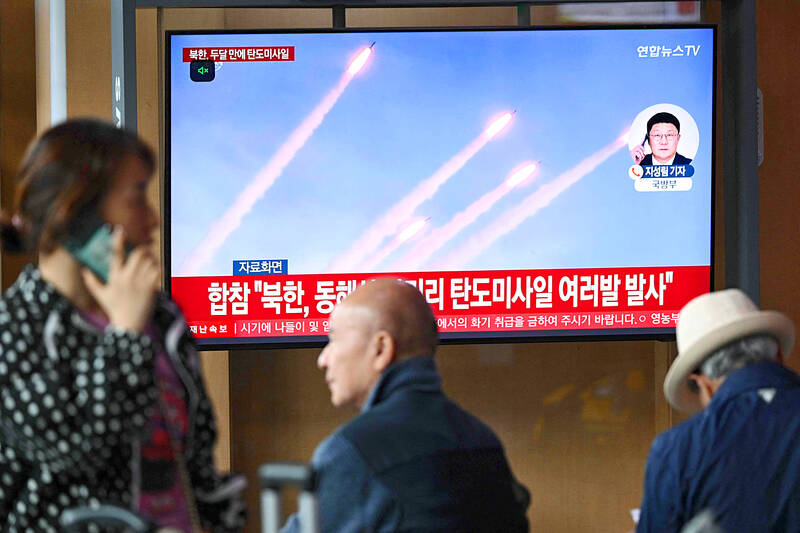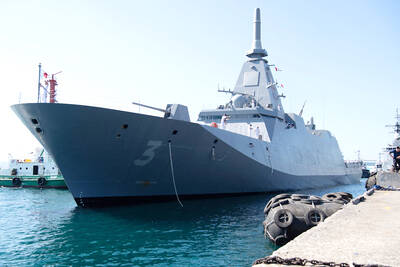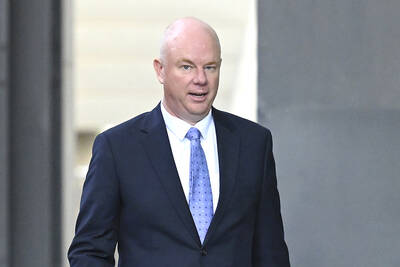North Korea yesterday fired what appeared to be multiple short-range ballistic missiles off its east coast, South Korea’s military said yesterday, possibly to test the performance and stability of various projectiles intended for export.
The missiles were launched from the eastern coastal city of Wonsan at about 8:10am and flew up to 800km before splashing down in the sea, the military said in a statement.
South Korea is closely communicating with the US and Japan to share information about the launch, it added.

Photo: AFP
The South Korean Ministry of Foreign Affairs said the three countries’ nuclear envoys consulted by telephone and condemned it as a violation of UN sanctions.
South Korea Joint Chiefs of Staff spokesman Lee Sung-jun declined to comment on the exact number of missiles detected or their characteristics, but told reporters the launch might have been to test the performance of missiles intended for export.
Hong Min, A North Korea analyst at the Korea Institute for National Unification, said they were likely two types of short-range ballistic missiles that had been supplied to Russia, which used them to strike Ukraine.
“There is considerable amount of field data of these two missiles collected, and it’s possible additional testing was needed to improve issues reported from the battlefield such as durability and precision,” Hong said.
Tokyo also said it detected a launch of a ballistic missile by North Korea, which might have flown on a irregular trajectory.
The launch came about a week after leader Kim Jong-un oversaw the test-firing of a new warship weapons system.
Pyongyang unveiled the 5,000-tonne destroyer-class vessel Choe Hyon last month. North Korea claims the vessel was equipped with the “most powerful weapons,” and that it would “enter into operation early next year.”
Some analysts have said the ship could be equipped with short-range tactical nuclear missiles — although North Korea has not proven it has the ability to miniaturize its nukes. The South Korean military has said the destroyer could have been developed with Russian help — possibly in exchange for Pyongyang deploying thousands of troops to help Moscow fight Kyiv.
Additional reporting by AFP

Nauru has started selling passports to fund climate action, but is so far struggling to attract new citizens to the low-lying, largely barren island in the Pacific Ocean. Nauru, one of the world’s smallest nations, has a novel plan to fund its fight against climate change by selling so-called “Golden Passports.” Selling for US$105,000 each, Nauru plans to drum up more than US$5 million in the first year of the “climate resilience citizenship” program. Almost six months after the scheme opened in February, Nauru has so far approved just six applications — covering two families and four individuals. Despite the slow start —

YELLOW SHIRTS: Many protesters were associated with pro-royalist groups that had previously supported the ouster of Paetongtarn’s father, Thaksin, in 2006 Protesters rallied on Saturday in the Thai capital to demand the resignation of court-suspended Thai Prime Minister Paetongtarn Shinawatra and in support of the armed forces following a violent border dispute with Cambodia that killed more than three dozen people and displaced more than 260,000. Gathered at Bangkok’s Victory Monument despite soaring temperatures, many sang patriotic songs and listened to speeches denouncing Paetongtarn and her father, former Thai prime minister Thaksin Shinawatra, and voiced their backing of the country’s army, which has always retained substantial power in the Southeast Asian country. Police said there were about 2,000 protesters by mid-afternoon, although

MOGAMI-CLASS FRIGATES: The deal is a ‘big step toward elevating national security cooperation with Australia, which is our special strategic partner,’ a Japanese official said Australia is to upgrade its navy with 11 Mogami-class frigates built by Japan’s Mitsubishi Heavy Industries, Australian Minister for Defence Richard Marles said yesterday. Billed as Japan’s biggest defense export deal since World War II, Australia is to pay US$6 billion over the next 10 years to acquire the fleet of stealth frigates. Australia is in the midst of a major military restructure, bolstering its navy with long-range firepower in an effort to deter China. It is striving to expand its fleet of major warships from 11 to 26 over the next decade. “This is clearly the biggest defense-industry agreement that has ever

DEADLY TASTE TEST: Erin Patterson tried to kill her estranged husband three times, police said in one of the major claims not heard during her initial trial Australia’s recently convicted mushroom murderer also tried to poison her husband with bolognese pasta and chicken korma curry, according to testimony aired yesterday after a suppression order lapsed. Home cook Erin Patterson was found guilty last month of murdering her husband’s parents and elderly aunt in 2023, lacing their beef Wellington lunch with lethal death cap mushrooms. A series of potentially damning allegations about Patterson’s behavior in the lead-up to the meal were withheld from the jury to give the mother-of-two a fair trial. Supreme Court Justice Christopher Beale yesterday rejected an application to keep these allegations secret. Patterson tried to kill her